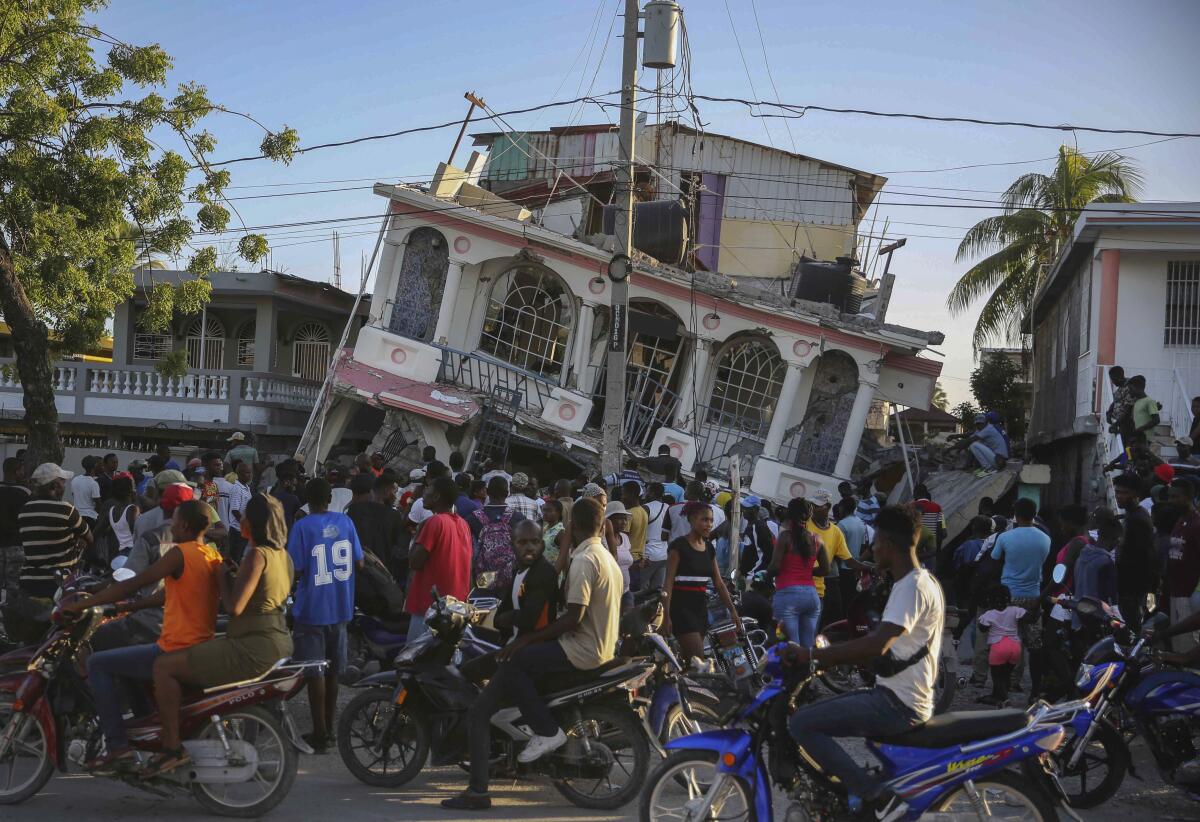Op-Ed: After a quake, crawling out alive won’t be enough

- Share via
Seeing the pictures of damage from the magnitude 7.2 earthquake in Haiti makes me think once again about what California will be like after our next big urban earthquake. Because we have, and mostly enforce, well-designed “life safety” building codes, we will be able to crawl out alive from any building built to those modern standards, and the death toll will be comparatively small.
But surviving isn’t the same as recovering. The losses from business disruption after a disaster often dwarf the losses in the event itself. We will need power, water and businesses up and running to chart our path to recovery. We have been making strides toward such resilience. The Los Angeles Department of Water and Power began a major seismic resilience program in 2014 to protect our water supplies. Southern California Edison has established a seismic resiliency program, working to protect the electric grid.
But back to our buildings. Because we have considered decisions about the financial risk of earthquakes to be a matter of personal choice, our life safety building codes ask only that a building not kill its inhabitants. After a quake, the building that didn’t crush you may nonetheless be a total loss, built to meet the bare minimum of the codes to save every possible penny in construction. Models of a big earthquake on the southern San Andreas fault estimate that as many as 10% of the high-rises designed to the current code in downtown Los Angeles (30 miles from the fault) will be so compromised they will have to be torn down after the earthquake. Our physical lives will have been spared, but our economic lives could well be in tatters.
Assembly Bill 1329, currently making its way through the California Legislature, would change this outcome, and give us what most of us think, or at least hope, we are already getting from the building codes — homes and offices that can be repaired and returned to use. Our economy cannot recover after an earthquake if we do not have places to work or live. Ensuring that the way we build now won’t bake in trillions of dollars in future losses is, I believe, the most important step we can take to protect the economic future of California.
Earthquake preparedness is about communication, resilience and understanding and mitigating your risks. Our newsletter course will teach you how.
The need for “functional recovery” rather than merely “life safety” building codes has been recognized for some time. The 6.3 magnitude 2011 Christchurch earthquake in New Zealand, where buildings were constructed to the same standards and with much the same techniques as California, showed the problem. No one there died in a modern building, yet 1,800 structures had to be torn down. Christchurch recovered because more than 90% of its buildings were covered by earthquake insurance. We know from state insurance data that fewer than 20% of our buildings have that protection.
A recent report from the Federal Emergency Management Agency and the National Institute of Standards and Technology recommended that states with a high seismic risk should enact functional recovery building codes to protect the economy at the local, regional and national level. California, with the highest earthquake risk of all 50 states, should lead the way in resilience just as we have in combatting climate change. We did not wait for federal or global action on climate change, and we have seen the benefits in jobs, revenue and overall economic vibrancy.
We will save more money in the long run than we will have to spend up front because building stronger does not cost that much more — functional recovery standards are estimated to add only 1% to 2% in building costs, a fraction of the cost of rebuilding after a total loss. But until the code requires all projects to meet that standard, most builders won’t make the investment. After all, they sell the building and the future losses are someone else’s problem.
We need homes and workplaces that survive with us after earthquakes. We know how to build better — we already put up stronger buildings in L.A. County than in Orange County because the expected shaking is stronger in Los Angeles. A better state building code could keep you from having to live in a shelter for months, from losing the investment you have in your home, from disruption in your work. Sacramento should set a standard that not only keeps us alive after a great quake, but functioning.
Lucy Jones is the founder of the Dr. Lucy Jones Center for Science and Society and the author of “The Big Ones.”
More to Read
A cure for the common opinion
Get thought-provoking perspectives with our weekly newsletter.
You may occasionally receive promotional content from the Los Angeles Times.











